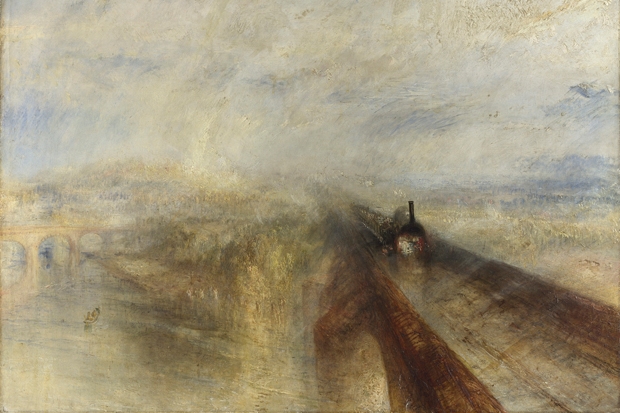Juvenilia is the work produced during an artist’s youth. It would seem logical to think, therefore, that an artist’s output during their old age would be classified as ‘senilia’. Yet no such word exists.
But how else to classify the three blockbuster exhibitions this year that deal with Matisse, Turner and Rembrandt’s late work? These titans produced some of their finest art during old age. The exuberance of Matisse’s cut-outs are all the more astonishing given that they were produced not in the first bloom of life but rather in the dying embers of it. Rembrandt’s late works — on display at the National Gallery from October and discussed by Martin Gayford on p64 — will include some of his most soulful paintings.
Late Turner at Tate Britain has a similar narrative. The bold vision in many of these paintings is startling given Turner’s age — 60 at the point the show starts — and the ailments that came with it: poor sight, diabetes, tremors in his hands. Turner’s critics dismissed his late paintings, proclaiming that they exposed the ‘folly of old age’. Alas, The Spectator joined the throng too. It pointed out in 1840:
the strange means that Turner takes to represent his diseased views of nature… It is easy to ridicule Turner — he is become a butt for every shaft: he beats Constable hollow at the argumentum ad absurdum: no painter living could caricature him so successfully as he does his own absurdities.
Yet these late paintings show Turner both engaging with and questioning the world around him. Many are meditations on the transiency of life. The sea — Turner’s greatest subject — is a metaphor for the storms of old age.
That Turner occasionally veers into abstraction has given weight to the argument that he was a visionary. But such formal analysis tends to ignore Turner’s reading of contemporary life. His late works examine the concerns of Victorian England, past, present and future. We see the legacy of the Napoleonic wars, the whaling industry, the industrial revolution.
The focus of this exhibition is not purely on the aesthetic — it has a thesis. It hopes to reassess the view that Turner’s last paintings transcend the era of their creation, and are best experienced as harbingers of modernism. Having said that, there is much pleasure to be had in losing yourself in these hydrous canvases, and no amount of sensible, matter-of-fact scholarship can diminish that.
Wonderful works such as ‘Snow Storm — Steam-Boat off a Harbour’s Mouth’ and ‘Returning From the Ball (St Martha)’ are displayed. By necessity, a handful of less-than-terrific paintings are also included for historical backdrop. It’s a concession made in order to prove Turner innocent of senility. During his later years, he took on a more paternal role at the Royal Academy, and would help young painters improve their canvases by retouching them. Daniel Maclise’s ‘Noah’s Sacrifice’ is one example. This painting is without merit, save for the fact that Turner’s brush touched it.
Such an archival approach highlights Turner’s weaknesses as well as his strengths. He was never very good at painting figures. To see this, you need only look at his ‘Bacchus and Ariadne’ (which, incidentally, The Spectator praised as ‘gorgeous’ in the very same piece from 1840). ‘In the “Ariadne”, the public may see, as far as I am aware, the worst figure that Turner painted, and perhaps that was ever painted by anybody,’ wrote Ruskin. But Turner considered himself just as much a painter of classical and modern history as a painter of landscape.
Ruskin is to blame for much misinterpretation of Turner. He refused to engage with either his classical themes or his modern, industrial ones. Instead, he believed Turner’s ‘modernity’ lay in his mastery of nature. But in two of his finest paintings — ‘Rain, Steam and Speed’ and ‘The Fighting Temeraire’ — there is no inherent discord between his modern material and his treatment of landscape. His hot, fiery light captures a country in the midst of change. Turner saw London as a modern Rome — a classical city, bound to fall. Yet Ruskin never came to terms with this. He assumed a moral high ground, arguing that Turner’s classicism rendered his efforts profane. In 1846, Ruskin declared Turner to be suffering from ‘mental disease’.
This idea of the ‘troubled genius’ has prevailed. But as these paintings show, Turner’s old age was industrious, echoing the industry of his age. His vision was fuelled by a lifetime’s love of literature, classicism, history and nature. He made few concessions to his ailing health and was a lifelong tourist. While in Venice, a companion ‘idling away the time’ with a cigar in a gondola felt ashamed to see Turner ‘hard at work’. In 1850, the Times commented that Turner appeared to have lived life backwards ‘having possessed in youth all the dignity of age only to exchange it for the effervescence of youth’.
The Victorians were shocked by Turner’s late style; the 20th century believed it echoed eternal truths. This exhibition sets out to present his senilia without either bout of hysteria. Turner once remarked that Ruskin saw more in his pictures than he ever painted. The beauty of this show is that it allows you to see what Ruskin noticed, but also what Turner meant.







Comments